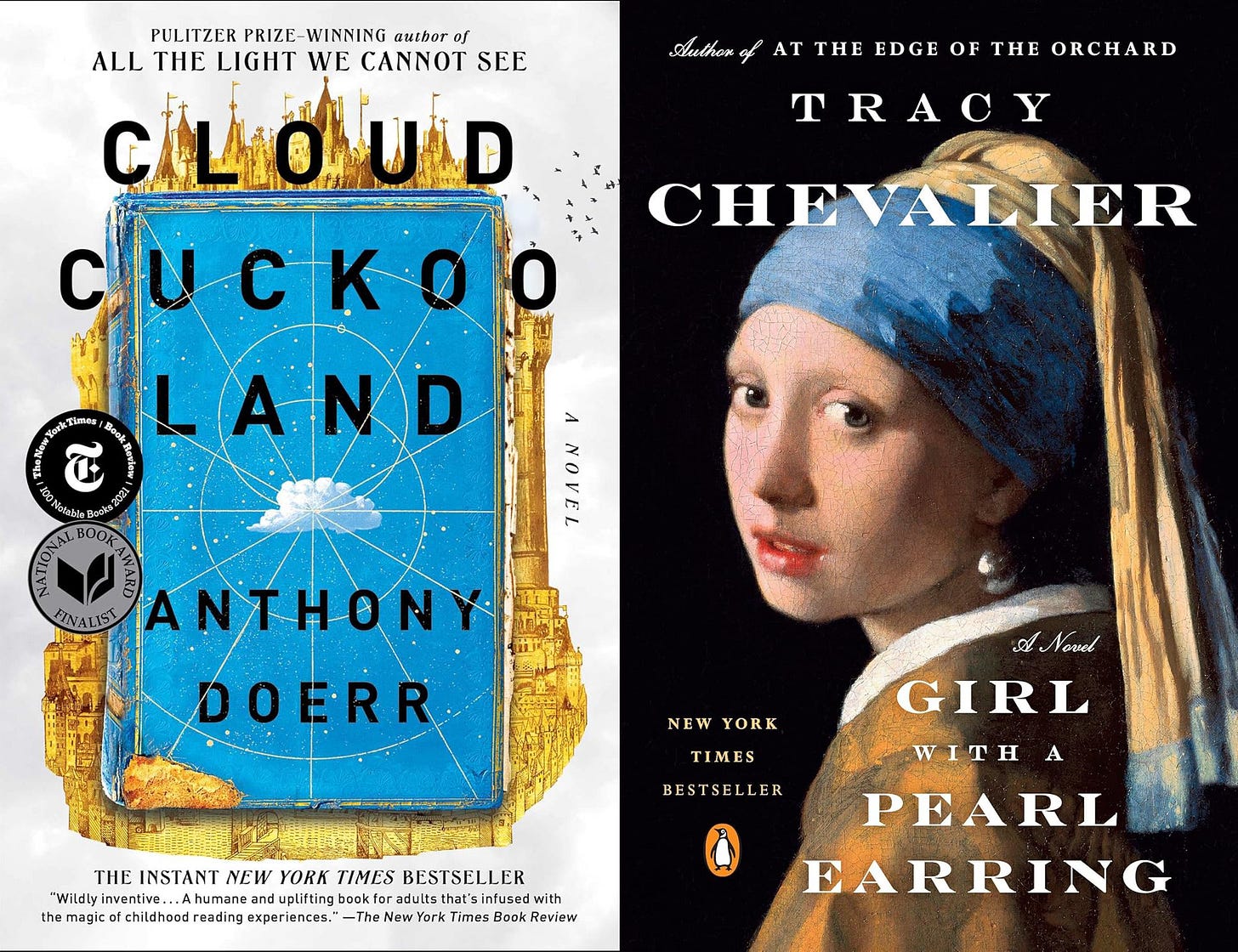Whatever novels I read back to back, no matter how disparate, my brain goes into a compare/contrast mode. I’m often surprised by the connections, so I offer them to you in a non-academic ramble.
Cloud Cuckoo Land, Anthony Doerr, 2021: historical, contemporary, and futuristic. Set in Ancient Greece, 16th-century Constantinople, 20 & 21st-century US, UK, Korea, and Mission Year 65, Space Ship Argos. 3rd person, present tense.
It took some work to find the structural rhythm: six point-of-view characters, four general time periods, and those with multiple internal shifts, tied together by a fictional lost & found manuscript of an ancient Greek novel. Whew! I enjoyed the AD 1453 siege storylines and the futurist plot the most. That’s no surprise. I’m typically less enamored with more recent periods.
The central motif of the Greek manuscript is a fun connection with the historical writer Antonius Diogenes’ The Wonders Beyond Thule—tying this imaginative tale to an imaginative writer of ancient fiction. Just the sort of thing we HF readers enjoy.
But my main driver for reading through it was pure curiosity: how is he going to pull off this clever convergence of timelines?
I appreciated the risky creativity despite the sci-fi tipping into (spoiler)1
I balked a little at the questionable climax of the contemporary storyline (spoiler)2
I’ve twice tried to read Doerr’s Pulitzer Prize Winner, All the Light We Cannot See, (Nazi occupied Paris), and can’t get past the opening. More proof that subject matter is key to my attention.
This one I enjoyed, but he had me at “Constantinople”.
Now, for the unlikely companion piece:
Girl with a Pearl Earring, Tracey Chevalier, 1999: historical fiction. Set in 1660s, Holland. 1st person, past tense.
I’m a late-comer to this long-term genre favorite,3 but I fell easily into the single point of view, straight-forward storytelling. About half-way through, I had a sudden fear it would become a gothic romance. Rest assured. It does not. The context of Vermeer’s household and the imagined daily life of the artist and our heroine’s navigation of her unique dilemma raises the story above the usual maid/master-of-the-house power dynamic.
Striking Commonalities:
With such structural differences, I was surprised at the similarities beyond the historical fiction genre.
Both are tightly character focused. Although Cuckoo involves so many, every rendering is a study of inner-workings and behavioral cause and effect. Doerr covers them in 600+ pages, so there is plenty of scope for examining each. In 230 pages, Chevalier explores her single point of view in depth, while her character weighs and studies those around her.
We also encounter the “orphan” and “coming of age” tropes. Of Doerr’s six POV characters, we have five coming of age and at least four are orphans. Chevalier’s MC is not technically an orphan but she is very much set apart from the safety of her own family. Her coming of age is played out in the careful suspense of the plot.
Surprisingly for the genre, neither novel makes narrative effort to describe the wider context of their worlds. They are immersion-via-character, not world-building. We are simply embedded, experiencing their experiences.
Doerr does not explain the Byzantine/Turk conflict that engulfs his 16th-century people. We learn nothing of the politics of the Korean War. We see only key moments of life in a prison camp. Doerr hints at why the futuristic society has committed less than 100 volunteers to a 592-year space mission, but does not elaborate. We are limited to the point of view characters’ understanding and what little they know of the circumstances engulfing them.
Chevalier gives us little of 17th-century Holland outside this two-year sequence of events in one household.
In both, we navigate the personal, environmental, social, and emotional landscapes directly.
Both conclude with what are essentially afterwards—fast forwards to descriptions of the central characters’ adult futures, lessons learned, distanced maturity. They provide a sigh of relief, but I wonder if they were necessary or even undo some of the dramatic tension that would otherwise have lingered over these stories.
And so, here we have two vastly different structures and yet laser focus on the direct experience of the characters.
You can conclude by my writing this summary that I finished them, which these days means I enjoyed them. I recently abandoned yet another novel after 37 pages of world-building. Like many historical fiction readers, it is the time/place that draws me. (see above re: my rejection of Doerr’s Pulitzer Prize winner). And I can take a lot more of the larger context than these novels provided, but it must be woven into the challenges and concerns of intriguing people.
Even if I am interested in the period, don’t make me wait for the story.
To go further, I’d get into spoilers, so I’ll stop here. Have you read either of these? What did you think?
a bit of Planet of the Apes, or flipping Ender’s Game on its head.
Couldn’t Zeno have just tossed it? Did he have to sacrifice himself? I get the dramatic benefit of this moment, but I question the rational.
I’ll explain my current reading methodology in a future essay. It’s highly scientific.






Hi Lausanne, I too found Doerr's Cloud Cuckoo Land tough to get into. I eventually did find the rhythm--read it a while back and I think the ending was worth the effort. I really enjoyed All the Light. At first I was more or less aghast that the protagonist was blind, I know, awful of me. But then it just moved me, and I found myself falling under his spell. I do like WWII novels, especially set in France, so that was probably part of the draw. Good you found some time to relax from your book!!! have a great summer.